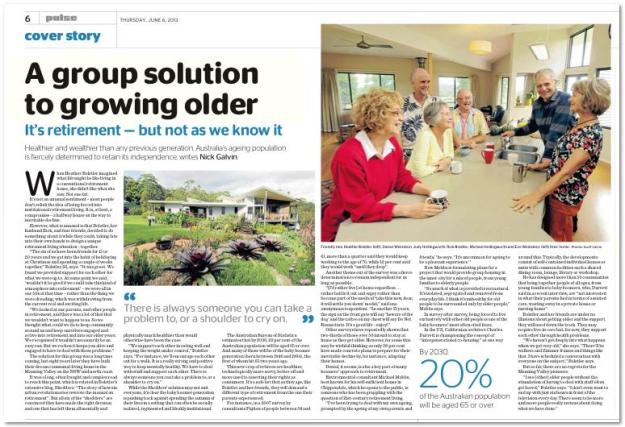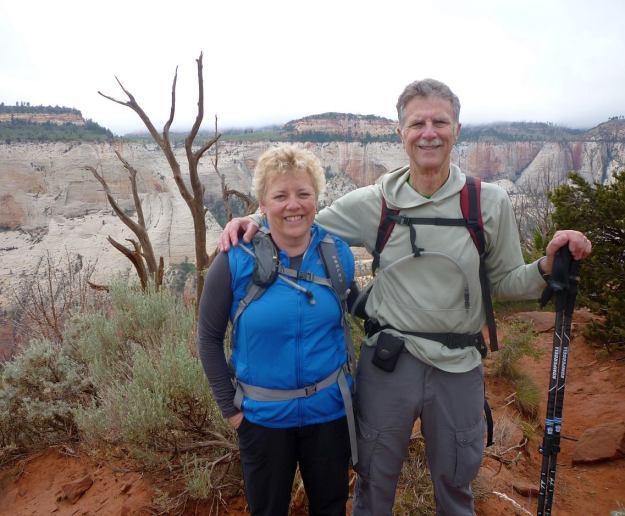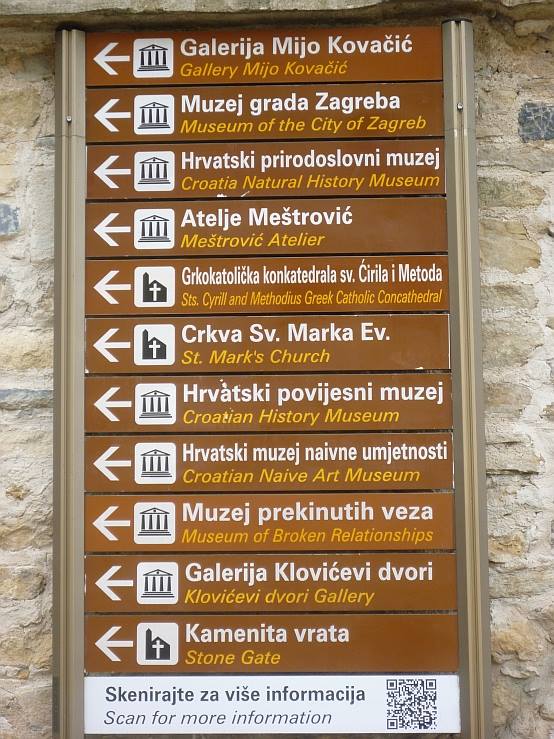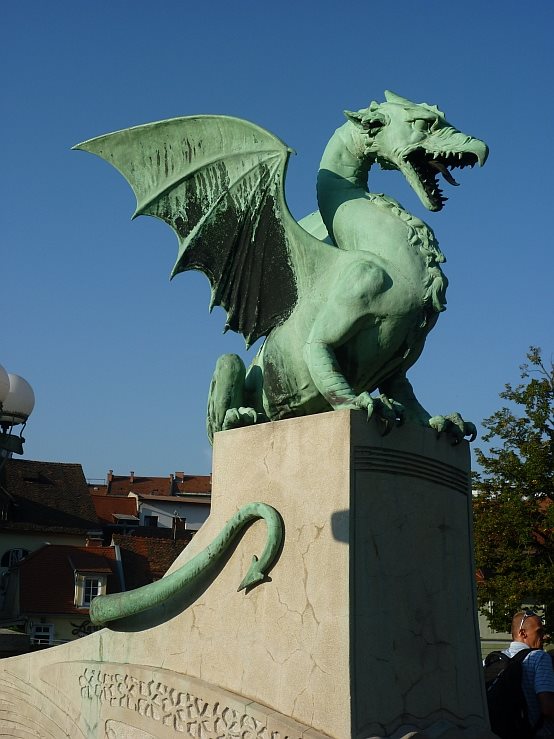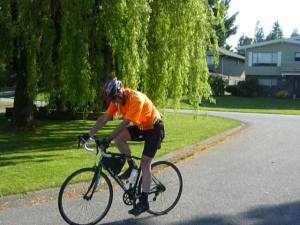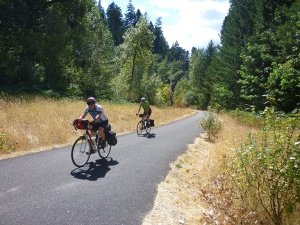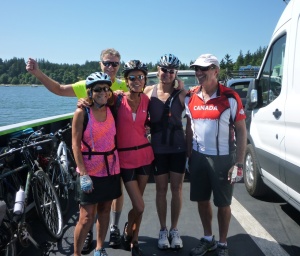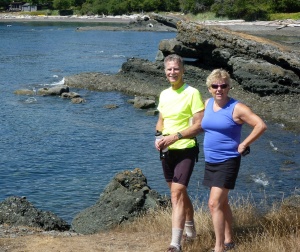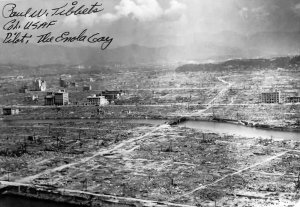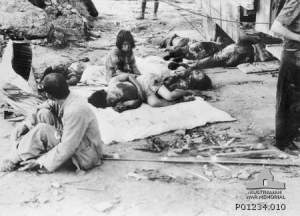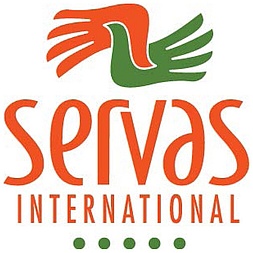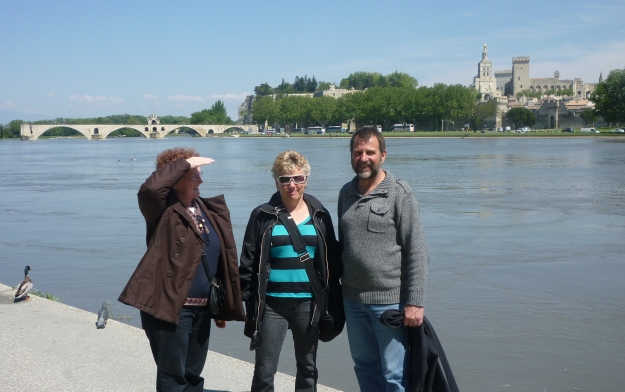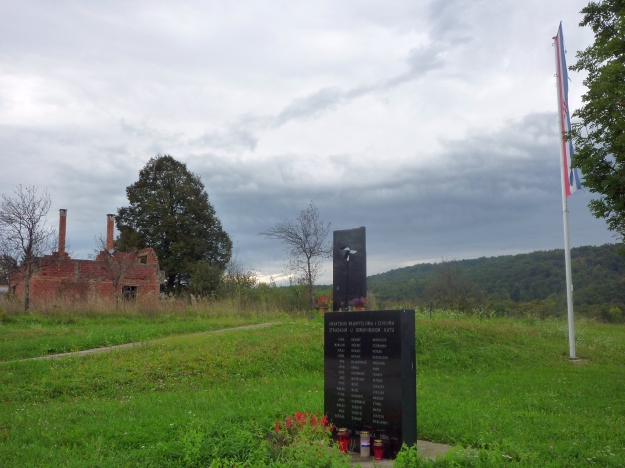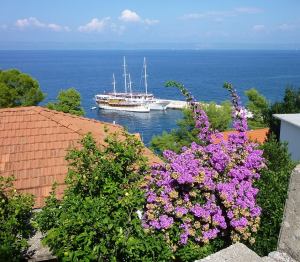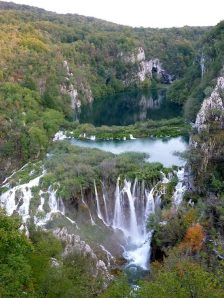Day 8: We awaken to continuing dismal rain today, but our spirits are rescued by the amazing variety of food at our buffet breakfast at the Romantic Hotel: full Chinese breakfast, plus full American breakfast, plus many varieties of exotic fruit. We head out from the hotel with our newly fitted bicycles and plastic raingear, determined not to let the rain stop us. Unlike the last bikes, these don’t have disc brakes, but we’re told to expect fewer hills. Still, the unrelenting rain makes both roads and tires slick, so we exercise some caution.
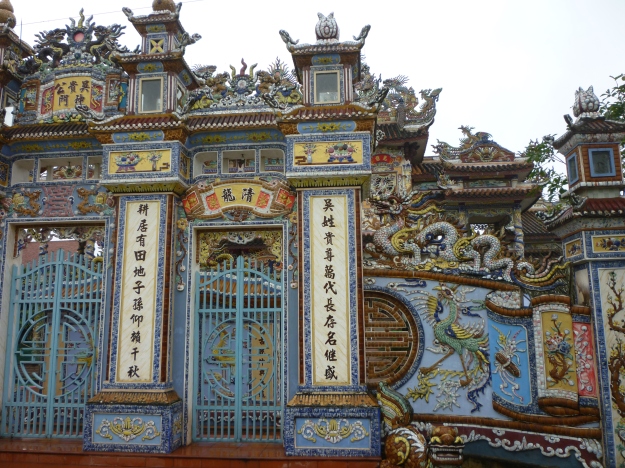
Wherever we cycle, we pass neighbourhood temples like this one outside Hue
After tasting water apples and milk apples at a local market, we visit a lady at her home who is making incense – placing sticks into a metal contraption that coats the upper part of the stick with a perfumed clay. She can turn out over 1000 sticks an hour. We all try our hand at it, but with the exception of Don, who’s a whiz in a workshop, our host has good reason not to be impressed. There must be many artisans like her, because incense is everywhere in Vietnam. It is thought to form a bridge between earth and heaven, and is used by millions requesting spiritual intervention with their earthly challenges. Upon passing temples and pagodas, we usually feel its sweet smoke catch in our throats.
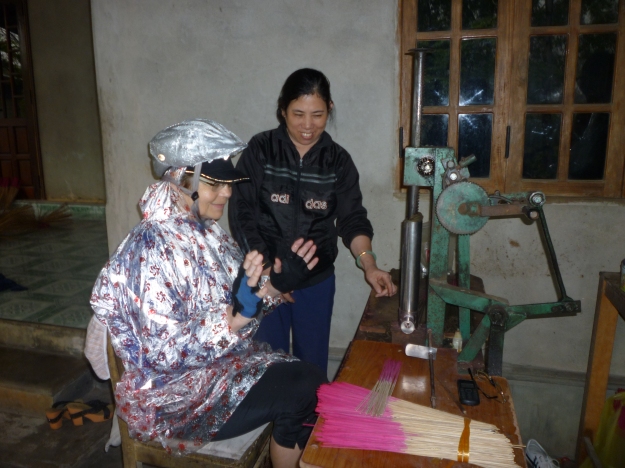
Rainy-day Rose Tries her Hand at Incense-making
Our guide Hoa teaches us a lot about the thirteen Emperors of the Nguyen Dynasty (that reigned from 1802-1945). Note: the word “Nyugen” is almost impossible for us English speakers to wrap our mouths around. Our group of six had six different pronunciations, even while sober and with our wits about us. Only Paul seemed to be able to provide a version that Hoa didn’t cringe at! “Very clear!” he would beam, “You should study Vietnamese.” (Paul explained that his pronunciation was somewhere between “Just like it’s spelled,” and “Wynn,” with a slight emphasis on the second syllable.)
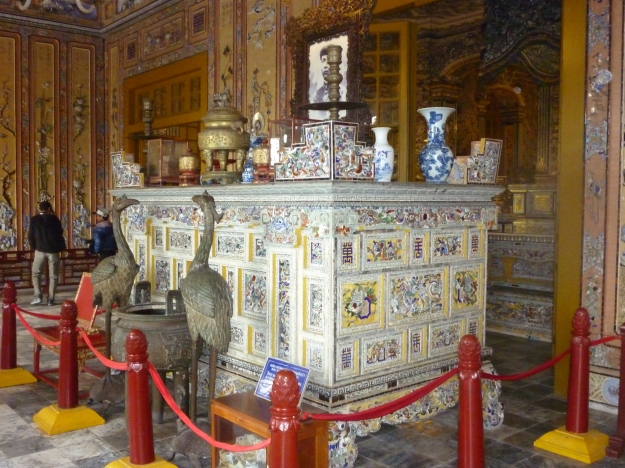
Typical Pagoda Altar
The first Nyugen emperor, Gai Long, reigned from 1802-1819 and unified the country. The nation officially became known as “Vietnam” during his reign. The 13th (and last) Nyugen emperor, Bao Dia, abdicated at the end of WWII, transferred power to the Democratic Republic of Vietnam, and lived out the rest of his life in France. (By this time, the Democratic Republic controlled only the South, while Ho Chi Minh’s communist party ruled the North.) Many of the emperors had many concubines, and therefore many children. The emperors would allow only eunuchs near their concubines, so those that were granted this equivocal privilege had high status, as did their families. A significant percentage of hopefuls, however, did not survive the enabling amputation.

The Middle Staircase was for the Emperor Alone
We visit the Thien Mu Pagoda on the Perfume River, the Imperial Citadel, and the Mausoleums of Tu Duc (1848-83) and Khai Dinh (1916-25). Tu Doc had over 100 wives and concubines, but his childhood illness denied him children, so he adopted a son. He was buried someone else in Hue, and the 200 laborers who buried him were beheaded afterwards, so the location is still a secret. Khai Dinh collaborated with the French regime in the mid-1800s and was very unpopular with the Vietnamese people. This collaboration led to 100 years of French colonial rule, and 40 years of war before Vietnam was officially reunited in 1975. (Various follow-on wars continued the blight on the next 36 years.)

Trying Out for Boy Emperor
The rain has kept the tourist count lower than usual, but bus loads of tourists still arrive, arrayed in multi-coloured plastic ponchos and carrying hotel umbrellas. Inside, they do the usual tourist things such as posing for photos on some past emperor’s throne.

These Incense Coils burn for Two Weeks
Meanwhile, Hoa teaches us the correct way to proffer incense in the pagodas – apparently, many native Vietnamese don’t know the whole story. The petitioner bows three times with the incense, once for the earth, once for the heavens, and once for the human being. Then she respectfully places the incense in the burner. Once again, Paul gets full marks for his technique. Hoa wants to make him an honourary Vietnamese.
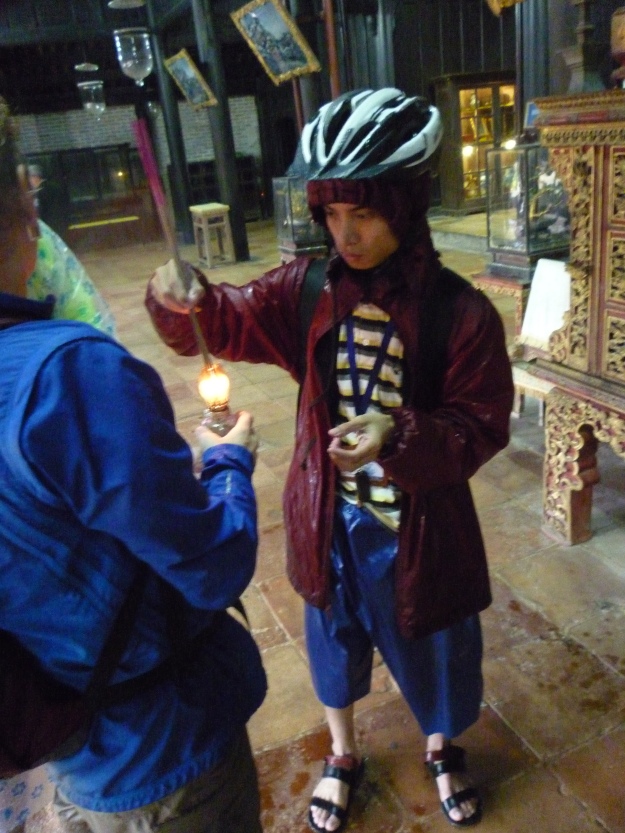
Hoa Tests our Incense Offering Technique
Soaked to the skin, we cut our day short and return to our hotel. We can see that Hoa is disappointed that we may miss the Heavenly Lady Pagoda, but as we tire from cycling in challenging conditions, we realize our margin of safety is impaired. It’s a real shame, as we can see that a sunny day would have made Hue perhaps the most beautiful cycle of our entire trip. We struggle not to let the gloom overtake us. Fortunately, the Romantic Hotel has a good price on massage, so Paul and I enjoy a side-by-side relaxing hour for about US$15 each.

Will we ever see the Heavenly Lady Pagoda?
Hoa tells us about “weasel coffee,” a brew made from beans that have gone through a civet cat, but we have yet to do a taste test against un-pre-digested coffee, so we don’t know if the extra cost is worth it. We continue to try out new beer. Huda and Halida seem to be topping the charts. Ba ba ba remains at the bottom.
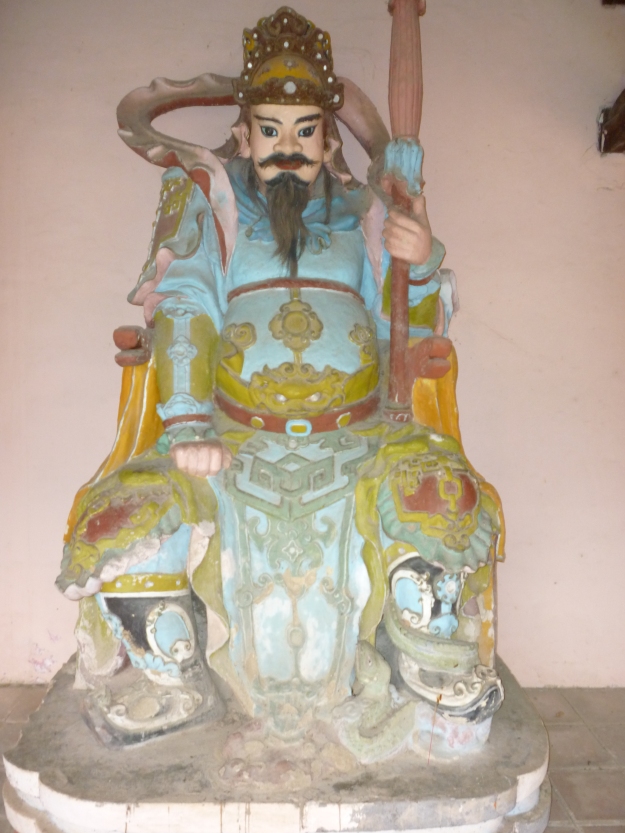
Guardian of the Pagoda
Day 9: After another amazing breakfast on our second day in Hue, we travel by van to the Heavenly Lady Pagoda. The grounds are beautiful, even in the continuing rain. They are also well kept, unsurprising since the resident monks’ daily chore-filled regimen appears to start before four in the morning.
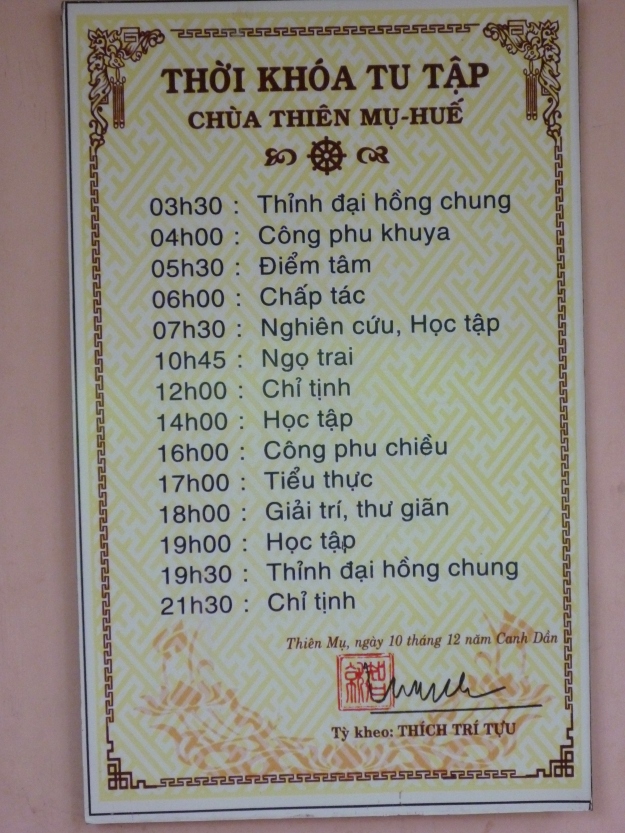
Monks’ Schedule includes several Karate Sessions
Leaving Hue, a brave two of our number cycle through the still-rainy countryside, and we stop for a delicious Vietnamese pancake, home-made by Chef-in-training, Lori. The rest of us pace the riders in the comfort of our van. A truck-load of bicycles follow should we change our minds.
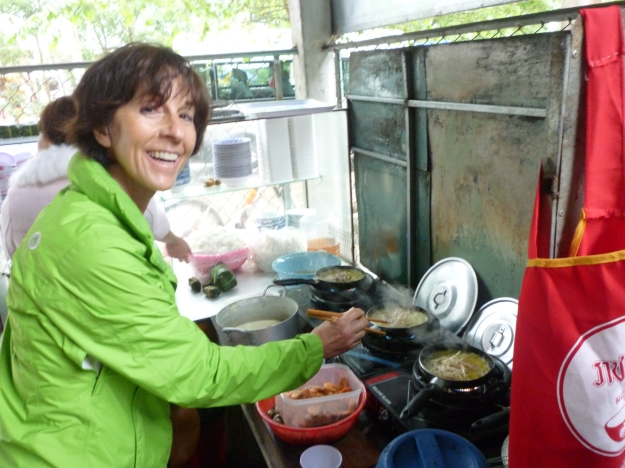
Lori made some Excellent Pancakes from Tiny Eggs
In fact, the rain lets up just in time for lunch at a seaside “a la carte” restaurant. This is the only meal on our tour that isn’t “set menu,” and a surprising number of us end up with french fries somewhere on their plates; often fried in coconut oil, Vietnamese fries are a tasty treat. This is perhaps our only meal of the two weeks that doesn’t include spring rolls.

Tiny Eggs at the Market (for pancakes?)
With no rain after lunch, most of us start a climb via lightly-traveled road to the top of the 500-meter high Hai Van pass, where the successful cyclists are warmly welcomed. The ocean views are spectacular, even under the clouds, and we can imagine the vistas with azure skies. Our guide Hoa, who is admittedly not a cyclist, also makes the summit.

Hoa and Paul celebrate their 1650-foot Ascent
He claims he’s paid double for this day – over 80 km of cycling – and I’m not sure he’s joking. This exertion is followed by a short van ride past the five-star beachfront resorts of Da Nang, to the ancient city of Hoi An. We have another nice dinner in a touristy area near the river, streets alight with silk lanterns, but our appetite for spring rolls is beginning to wane.
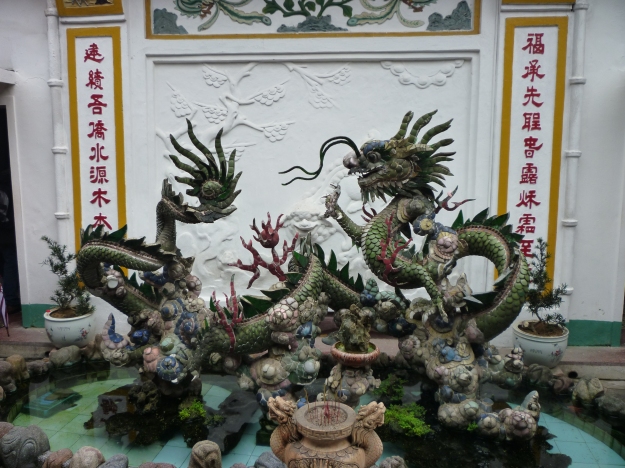
Dragon in Chinese Temple in Hoi An
Day 10: On our last day in Hoi An, we visit a Chinese temple, one of many where individuals and even companies pay large amounts of money to purchase a spiral incense contraption that will burn for a fortnight. We have a tour of a silk factory where women product beautiful tapestries and clothing for sale.
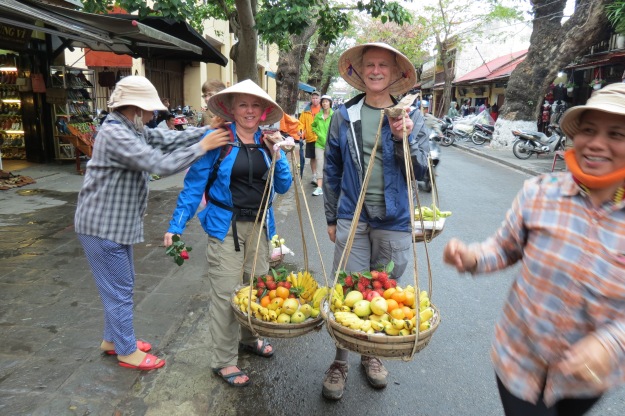
Not About to Give up our Day Jobs
While beautiful, Hoi An is the most touristed place we will visit in Vietnam. Crowds are everywhere, and other tourists on bicycles are more dangerous than locals on scooters. A friendly behatted pair carrying traditional fruit baskets ask us if we want to see how heavy they are. (Quite.) We take turns being photographed staggering under the weight, followed by buying some fruit at several times the market (rates – the extra covers the photo op, I guess.
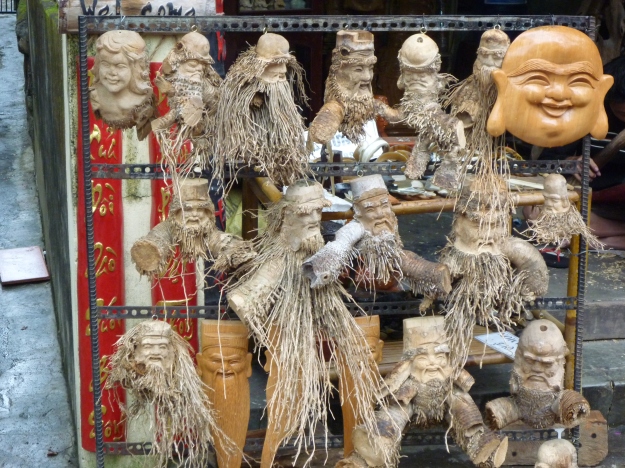
Art made from Bamboo Roots
Sometimes the impromptu stops are the best. While in Hoi An, we came upon a temporary roadside shelter, where a few older men where offering a feast to their ancestors. The food was laid out attractively under the canopy, and some of the old men played on simple musical instruments. Wondering what would become of the offering, Paul posed the question to Hoa, and he assured us that, once the ceremony was complete, the men would enjoy eating the food themselves.
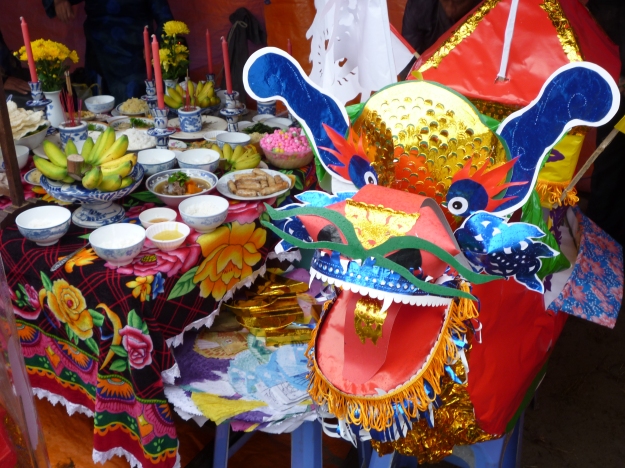
Local Offering to the Ancestors
Good to know. On our rides, we’ve seen many modest Vietnamese homes, overshadowed by temples and tombs far more opulent than their earthly abodes. Between richly endowed temples, tombs, pagodas, schools, and communist party buildings, there doesn’t seem to be so much wealth left for day-to-day living.
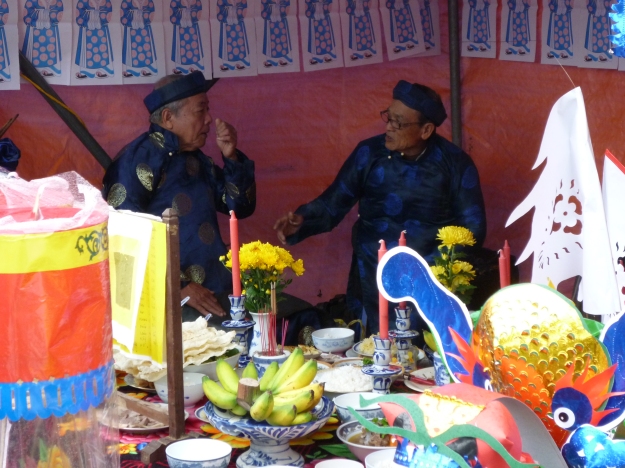
Feasting Ahead
Our final ride is a cycle to Cua Dai beach following the ever watchful lead of Mr. Tien, Hoa’s cyclist alter-ego. Mr. Tien speaks little English, but we all feel a deep connection to his friendly demeanor, and he is an expert cyclist and ride leader. We understand he has planned many of our cycle routes in Central Vietnam.
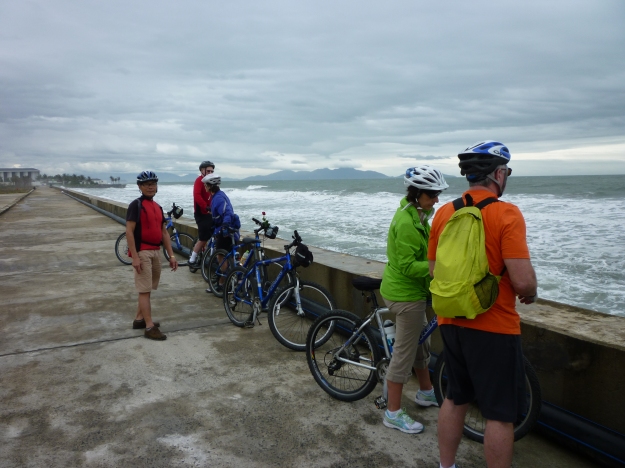
Mr. Tien shows us the East Vietnam (a.k.a. South China) Sea
Cycling back to our Hoi An hotel for our final night before flying south, we stop to watch some preschoolers giving their parents an outdoor dance recital in front of their school. One of the teachers invites us inside the gates, where we smile and make goo-goo eyes at the cute little youngsters. It seems a wonderful way to end our too-short visit to Central Vietnam. Paul says he’d like to spend more time in this part of the country, but tomorrow early we fly to Saigon. So early, in fact, that the hotel staff obligingly offer to open the entire breakfast room well before the advertised hour. As with almost all the hospitality staff in Vietnam, they seem so eager to serve their clients in any way possible.

These Kids were Great Performers
For more information:
- Lac Viet – our tour operator
- Biketours.com – the US company that did all the arangements
- Tien Bicycles Adventure Travel – the local ride leader for Central Vietnam
Related posts:
- Next (& last) post: Cycling in Vietnam: Saigon & the Mekong
- Part One: Cycling in Vietnam – Hanoi
- Why Travel Alone?
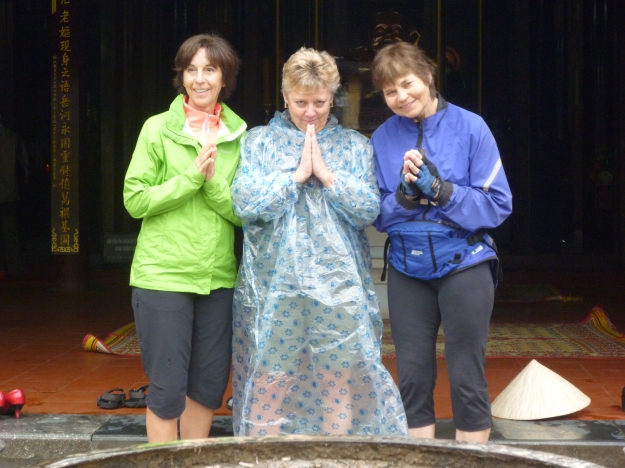
Heavenly Ladies at the Pagoda

